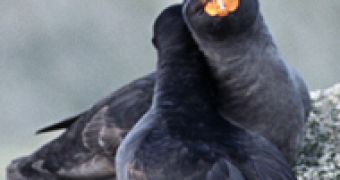Insecticides turn you impotent rather than rousing you, but not the same occurs with the crested auklets and their home made bug killing chemicals. These arctic sea birds have been found to produce citrus-scented pheromones that repel ticks while at the same time attracting mates.
This finding explains the long-standing puzzle of the chemicals' goal, and why these birds rub each other with these secretions during courtship. It is the first found case of chemical defenses transfer between birds.
Crested auklets (Aethia cristatella) inhabit massive colonies on islands off eastern Siberia and Alaska. Chemicals similar to the auklet secretions work as insecticides in other species, too, that's why the research team suspected they could act as a natural defense against the ticks and other parasite arthropods.
But as the auklets rub their strongly "perfumed" napes of each other's necks during courtship, the secretion was also thought to act as a sexual attractant. But these birds are almost impossible to investigate in the wild, due to the remoteness of their habitat and the nesting on steep dangerous cliffs.
Hector Douglas, biologist at the University of Alaska, Fairbanks, placed two taxidermic auklets into an enclosure with 14 live birds at the Cincinnati Zoo, on top of rock piles and dispensers placed underneath spreading the smell of a synthetic type of the auklet "essence."
"Auklets approached the scented piles more than twice as often as they did control dispensers containing only ethanol, even rubbing their bills in the scented dispensers," reported Douglas.
Douglas noticed that wild birds on Alaska's St. Lawrence Island were attracted to the scent, but he did not use the control in these experiments. Douglas put ticks near a droplet of the synthetic essence on a petri dish. The chemical did not kill the ticks, but it did slow their pace by over 50% compared to ethanol controls. He also detected the source of the compound for the first time, with the help of chemical assays and electron microscopy: translucent, hair-like feathers with hollow cores (named wick feathers), located between the shoulder blades.
"These are incredibly exciting conclusions. More work is needed, especially as the ticks used were not the same species that parasitize auklets in the wild and because the study sample was small", said Ian Jones, a behavioral ecologist at the Memorial University in St. John's, Canada.

 14 DAY TRIAL //
14 DAY TRIAL //